Analysis of Problematic Substance Use in Healthcare Settings
VerifiedAdded on 2023/01/19
|10
|2854
|90
Report
AI Summary
This report delves into the multifaceted issue of problematic substance use, examining its causes, including trauma, mental unwellness, and peer pressure, as well as its effects on individuals. It explores the application of the Strategic Prevention Framework (SPF) and Trauma-Informed Care (TIC) in healthcare settings, emphasizing the importance of patient safety, collaboration, and empowerment. The report highlights the link between mental illness and substance addiction, discussing the role of nurses in fostering patient engagement and promoting recovery. It also addresses the significance of collaborative care between mental health nurses and family nurse practitioners, stressing the need for integrated treatment approaches and the application of TICP principles to ensure comprehensive and effective care. The report emphasizes the importance of information sharing, unbiased precautions and sensitivity to the patient's history to foster a supportive environment for recovery and well-being.

Running Head; Problematic Substance Use
Problematic substance use
Introduction
Substance Abuse according to World Health Organization (2016) is the dangerous use of
psychoactive substances which can result to a syndrome known as dependence syndrome.
Mostly abused substances include illegal drugs such as cocaine, nicotine, marijuana and many
other harmful drugs, inclusive of alcohol. Dependence syndrome is characterized by cognitive
behavioral and physiological changes on user after a repeated use of these drugs. It involves
irresistible desire to take the drug and continuous use regardless of the fatal outcomes. The used
of drug then becomes more important that other responsibilities, tolerance increases and physical
withdrawal sometimes creeps in.
Identification of the chosen issues
Drug addiction, otherwise known as substance use disorder is therefore an illness that
changes a person, the user’s normal behavior and brain functions leading to leading to
uncontrolled use of illegal, legal drugs and on a larger scale, the medication. Health care taking
parts in health problems arising from substance abuse has helped in the restoration of health of
affected persons and significantly reduce cases of addiction (Centre for Addictions and Mental
Health, 2012) From the video of Mark, the three issues that may have contributed to substance
abuse and addictions are bad past experience (trauma), mental unwellness and peer pressure.
Addiction stems from experimental drug use for fun maybe during social activities such as
parties or exposure to defined medications then later becomes a habit. The speed at which an
Problematic substance use
Introduction
Substance Abuse according to World Health Organization (2016) is the dangerous use of
psychoactive substances which can result to a syndrome known as dependence syndrome.
Mostly abused substances include illegal drugs such as cocaine, nicotine, marijuana and many
other harmful drugs, inclusive of alcohol. Dependence syndrome is characterized by cognitive
behavioral and physiological changes on user after a repeated use of these drugs. It involves
irresistible desire to take the drug and continuous use regardless of the fatal outcomes. The used
of drug then becomes more important that other responsibilities, tolerance increases and physical
withdrawal sometimes creeps in.
Identification of the chosen issues
Drug addiction, otherwise known as substance use disorder is therefore an illness that
changes a person, the user’s normal behavior and brain functions leading to leading to
uncontrolled use of illegal, legal drugs and on a larger scale, the medication. Health care taking
parts in health problems arising from substance abuse has helped in the restoration of health of
affected persons and significantly reduce cases of addiction (Centre for Addictions and Mental
Health, 2012) From the video of Mark, the three issues that may have contributed to substance
abuse and addictions are bad past experience (trauma), mental unwellness and peer pressure.
Addiction stems from experimental drug use for fun maybe during social activities such as
parties or exposure to defined medications then later becomes a habit. The speed at which an
Paraphrase This Document
Need a fresh take? Get an instant paraphrase of this document with our AI Paraphraser
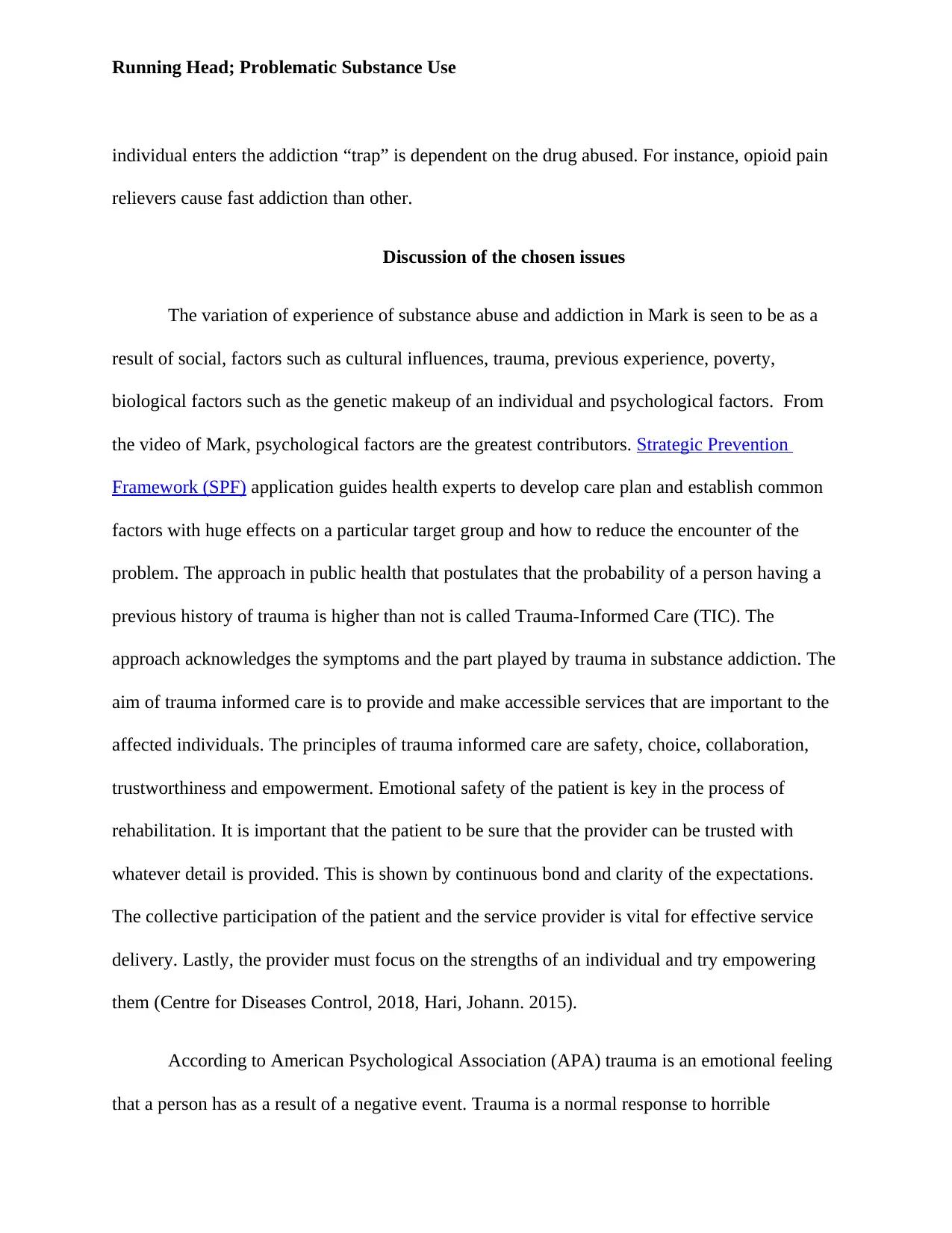
Running Head; Problematic Substance Use
individual enters the addiction “trap” is dependent on the drug abused. For instance, opioid pain
relievers cause fast addiction than other.
Discussion of the chosen issues
The variation of experience of substance abuse and addiction in Mark is seen to be as a
result of social, factors such as cultural influences, trauma, previous experience, poverty,
biological factors such as the genetic makeup of an individual and psychological factors. From
the video of Mark, psychological factors are the greatest contributors. Strategic Prevention
Framework (SPF) application guides health experts to develop care plan and establish common
factors with huge effects on a particular target group and how to reduce the encounter of the
problem. The approach in public health that postulates that the probability of a person having a
previous history of trauma is higher than not is called Trauma-Informed Care (TIC). The
approach acknowledges the symptoms and the part played by trauma in substance addiction. The
aim of trauma informed care is to provide and make accessible services that are important to the
affected individuals. The principles of trauma informed care are safety, choice, collaboration,
trustworthiness and empowerment. Emotional safety of the patient is key in the process of
rehabilitation. It is important that the patient to be sure that the provider can be trusted with
whatever detail is provided. This is shown by continuous bond and clarity of the expectations.
The collective participation of the patient and the service provider is vital for effective service
delivery. Lastly, the provider must focus on the strengths of an individual and try empowering
them (Centre for Diseases Control, 2018, Hari, Johann. 2015).
According to American Psychological Association (APA) trauma is an emotional feeling
that a person has as a result of a negative event. Trauma is a normal response to horrible
individual enters the addiction “trap” is dependent on the drug abused. For instance, opioid pain
relievers cause fast addiction than other.
Discussion of the chosen issues
The variation of experience of substance abuse and addiction in Mark is seen to be as a
result of social, factors such as cultural influences, trauma, previous experience, poverty,
biological factors such as the genetic makeup of an individual and psychological factors. From
the video of Mark, psychological factors are the greatest contributors. Strategic Prevention
Framework (SPF) application guides health experts to develop care plan and establish common
factors with huge effects on a particular target group and how to reduce the encounter of the
problem. The approach in public health that postulates that the probability of a person having a
previous history of trauma is higher than not is called Trauma-Informed Care (TIC). The
approach acknowledges the symptoms and the part played by trauma in substance addiction. The
aim of trauma informed care is to provide and make accessible services that are important to the
affected individuals. The principles of trauma informed care are safety, choice, collaboration,
trustworthiness and empowerment. Emotional safety of the patient is key in the process of
rehabilitation. It is important that the patient to be sure that the provider can be trusted with
whatever detail is provided. This is shown by continuous bond and clarity of the expectations.
The collective participation of the patient and the service provider is vital for effective service
delivery. Lastly, the provider must focus on the strengths of an individual and try empowering
them (Centre for Diseases Control, 2018, Hari, Johann. 2015).
According to American Psychological Association (APA) trauma is an emotional feeling
that a person has as a result of a negative event. Trauma is a normal response to horrible

Running Head; Problematic Substance Use
happenings however, its effects can prove disastrous to an individual. The traumatic events
reappear in the victim’s memory hence likely to abuse substances in hope of forgetting the
happening neglect verbal abuse physical abuse, just like the case of Mark. Events such as
terrorism, sexual abuse, negligence, natural disasters, and accidents among others may lead to
trauma. In dealing with mental illness as a risk factor for substance abuse, collaboration and
burying the levels of power is important. In this case, the nurse and the patient are equal to
encourage the patient and make him feel that he matters. Recovery happens faster when
relationships between these people are not compromised. Everybody has a role to play in a TI
approach. There is a strong link between mental illness and substance addiction. According to
the National Alliance on Mental Illness (2016), cases up to more than a half of drugs abusers are
struggling with mental health. They use these drugs to relieve stress or pain that are related to
their sickness. While numerous individuals associate peer influence strictly with children and
young adults, it does manifest itself in grown-ups as well. All things considered; the impact is
generally encompassing who they live with. Planning to re-experience that first high, a calm
accomplice may participate and uncork to vituperate drugs with their life partner. Others
consider it to be an approach to unfasten harmony in their relationship. While supplanting
battling with utilizing medications may appear to be an answer at the time, a backslide is
basically not justified, despite any potential benefits (Whitesell, Bachand, Peel, & Brown, 2013).
The nurses are obligated to empower the emotions of their clients and let them believe that there
is hope in the end. In a nutshell, the relationship between addiction management and trauma
informed care is very close and almost the same as that of recovery and resilience in the sense
that they translate to proper care of suffering from addiction and trauma.
happenings however, its effects can prove disastrous to an individual. The traumatic events
reappear in the victim’s memory hence likely to abuse substances in hope of forgetting the
happening neglect verbal abuse physical abuse, just like the case of Mark. Events such as
terrorism, sexual abuse, negligence, natural disasters, and accidents among others may lead to
trauma. In dealing with mental illness as a risk factor for substance abuse, collaboration and
burying the levels of power is important. In this case, the nurse and the patient are equal to
encourage the patient and make him feel that he matters. Recovery happens faster when
relationships between these people are not compromised. Everybody has a role to play in a TI
approach. There is a strong link between mental illness and substance addiction. According to
the National Alliance on Mental Illness (2016), cases up to more than a half of drugs abusers are
struggling with mental health. They use these drugs to relieve stress or pain that are related to
their sickness. While numerous individuals associate peer influence strictly with children and
young adults, it does manifest itself in grown-ups as well. All things considered; the impact is
generally encompassing who they live with. Planning to re-experience that first high, a calm
accomplice may participate and uncork to vituperate drugs with their life partner. Others
consider it to be an approach to unfasten harmony in their relationship. While supplanting
battling with utilizing medications may appear to be an answer at the time, a backslide is
basically not justified, despite any potential benefits (Whitesell, Bachand, Peel, & Brown, 2013).
The nurses are obligated to empower the emotions of their clients and let them believe that there
is hope in the end. In a nutshell, the relationship between addiction management and trauma
informed care is very close and almost the same as that of recovery and resilience in the sense
that they translate to proper care of suffering from addiction and trauma.
⊘ This is a preview!⊘
Do you want full access?
Subscribe today to unlock all pages.

Trusted by 1+ million students worldwide
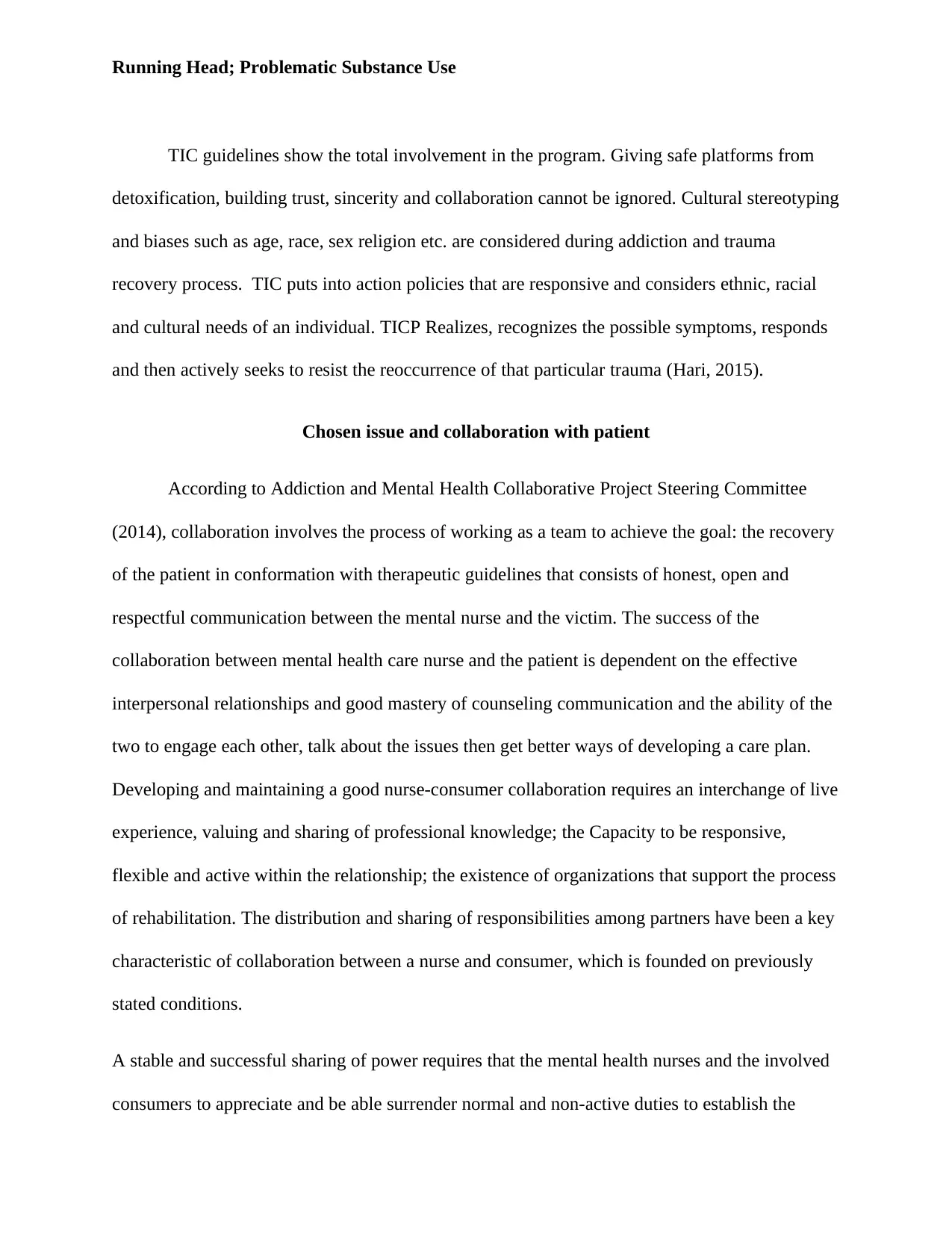
Running Head; Problematic Substance Use
TIC guidelines show the total involvement in the program. Giving safe platforms from
detoxification, building trust, sincerity and collaboration cannot be ignored. Cultural stereotyping
and biases such as age, race, sex religion etc. are considered during addiction and trauma
recovery process. TIC puts into action policies that are responsive and considers ethnic, racial
and cultural needs of an individual. TICP Realizes, recognizes the possible symptoms, responds
and then actively seeks to resist the reoccurrence of that particular trauma (Hari, 2015).
Chosen issue and collaboration with patient
According to Addiction and Mental Health Collaborative Project Steering Committee
(2014), collaboration involves the process of working as a team to achieve the goal: the recovery
of the patient in conformation with therapeutic guidelines that consists of honest, open and
respectful communication between the mental nurse and the victim. The success of the
collaboration between mental health care nurse and the patient is dependent on the effective
interpersonal relationships and good mastery of counseling communication and the ability of the
two to engage each other, talk about the issues then get better ways of developing a care plan.
Developing and maintaining a good nurse-consumer collaboration requires an interchange of live
experience, valuing and sharing of professional knowledge; the Capacity to be responsive,
flexible and active within the relationship; the existence of organizations that support the process
of rehabilitation. The distribution and sharing of responsibilities among partners have been a key
characteristic of collaboration between a nurse and consumer, which is founded on previously
stated conditions.
A stable and successful sharing of power requires that the mental health nurses and the involved
consumers to appreciate and be able surrender normal and non-active duties to establish the
TIC guidelines show the total involvement in the program. Giving safe platforms from
detoxification, building trust, sincerity and collaboration cannot be ignored. Cultural stereotyping
and biases such as age, race, sex religion etc. are considered during addiction and trauma
recovery process. TIC puts into action policies that are responsive and considers ethnic, racial
and cultural needs of an individual. TICP Realizes, recognizes the possible symptoms, responds
and then actively seeks to resist the reoccurrence of that particular trauma (Hari, 2015).
Chosen issue and collaboration with patient
According to Addiction and Mental Health Collaborative Project Steering Committee
(2014), collaboration involves the process of working as a team to achieve the goal: the recovery
of the patient in conformation with therapeutic guidelines that consists of honest, open and
respectful communication between the mental nurse and the victim. The success of the
collaboration between mental health care nurse and the patient is dependent on the effective
interpersonal relationships and good mastery of counseling communication and the ability of the
two to engage each other, talk about the issues then get better ways of developing a care plan.
Developing and maintaining a good nurse-consumer collaboration requires an interchange of live
experience, valuing and sharing of professional knowledge; the Capacity to be responsive,
flexible and active within the relationship; the existence of organizations that support the process
of rehabilitation. The distribution and sharing of responsibilities among partners have been a key
characteristic of collaboration between a nurse and consumer, which is founded on previously
stated conditions.
A stable and successful sharing of power requires that the mental health nurses and the involved
consumers to appreciate and be able surrender normal and non-active duties to establish the
Paraphrase This Document
Need a fresh take? Get an instant paraphrase of this document with our AI Paraphraser
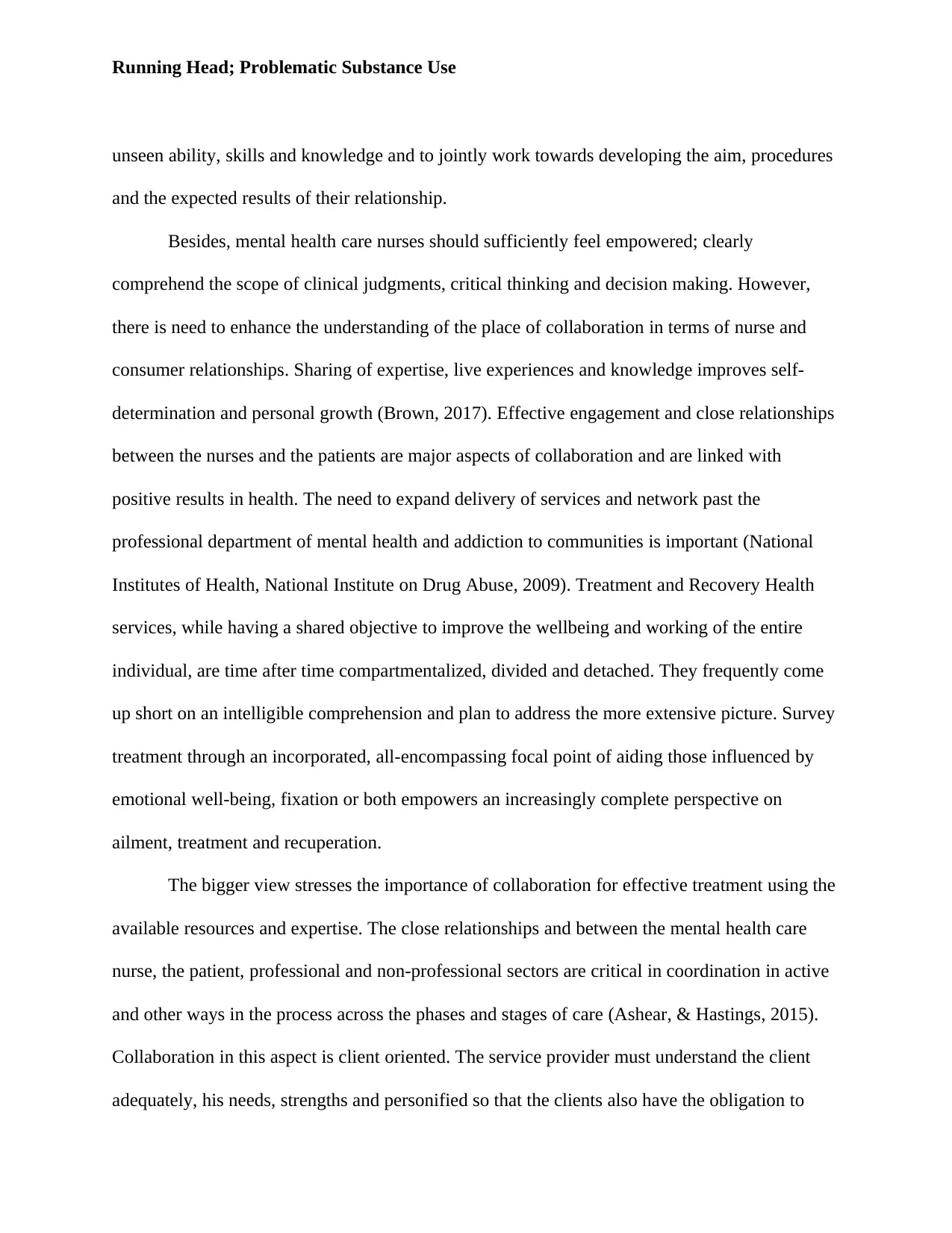
Running Head; Problematic Substance Use
unseen ability, skills and knowledge and to jointly work towards developing the aim, procedures
and the expected results of their relationship.
Besides, mental health care nurses should sufficiently feel empowered; clearly
comprehend the scope of clinical judgments, critical thinking and decision making. However,
there is need to enhance the understanding of the place of collaboration in terms of nurse and
consumer relationships. Sharing of expertise, live experiences and knowledge improves self-
determination and personal growth (Brown, 2017). Effective engagement and close relationships
between the nurses and the patients are major aspects of collaboration and are linked with
positive results in health. The need to expand delivery of services and network past the
professional department of mental health and addiction to communities is important (National
Institutes of Health, National Institute on Drug Abuse, 2009). Treatment and Recovery Health
services, while having a shared objective to improve the wellbeing and working of the entire
individual, are time after time compartmentalized, divided and detached. They frequently come
up short on an intelligible comprehension and plan to address the more extensive picture. Survey
treatment through an incorporated, all-encompassing focal point of aiding those influenced by
emotional well-being, fixation or both empowers an increasingly complete perspective on
ailment, treatment and recuperation.
The bigger view stresses the importance of collaboration for effective treatment using the
available resources and expertise. The close relationships and between the mental health care
nurse, the patient, professional and non-professional sectors are critical in coordination in active
and other ways in the process across the phases and stages of care (Ashear, & Hastings, 2015).
Collaboration in this aspect is client oriented. The service provider must understand the client
adequately, his needs, strengths and personified so that the clients also have the obligation to
unseen ability, skills and knowledge and to jointly work towards developing the aim, procedures
and the expected results of their relationship.
Besides, mental health care nurses should sufficiently feel empowered; clearly
comprehend the scope of clinical judgments, critical thinking and decision making. However,
there is need to enhance the understanding of the place of collaboration in terms of nurse and
consumer relationships. Sharing of expertise, live experiences and knowledge improves self-
determination and personal growth (Brown, 2017). Effective engagement and close relationships
between the nurses and the patients are major aspects of collaboration and are linked with
positive results in health. The need to expand delivery of services and network past the
professional department of mental health and addiction to communities is important (National
Institutes of Health, National Institute on Drug Abuse, 2009). Treatment and Recovery Health
services, while having a shared objective to improve the wellbeing and working of the entire
individual, are time after time compartmentalized, divided and detached. They frequently come
up short on an intelligible comprehension and plan to address the more extensive picture. Survey
treatment through an incorporated, all-encompassing focal point of aiding those influenced by
emotional well-being, fixation or both empowers an increasingly complete perspective on
ailment, treatment and recuperation.
The bigger view stresses the importance of collaboration for effective treatment using the
available resources and expertise. The close relationships and between the mental health care
nurse, the patient, professional and non-professional sectors are critical in coordination in active
and other ways in the process across the phases and stages of care (Ashear, & Hastings, 2015).
Collaboration in this aspect is client oriented. The service provider must understand the client
adequately, his needs, strengths and personified so that the clients also have the obligation to
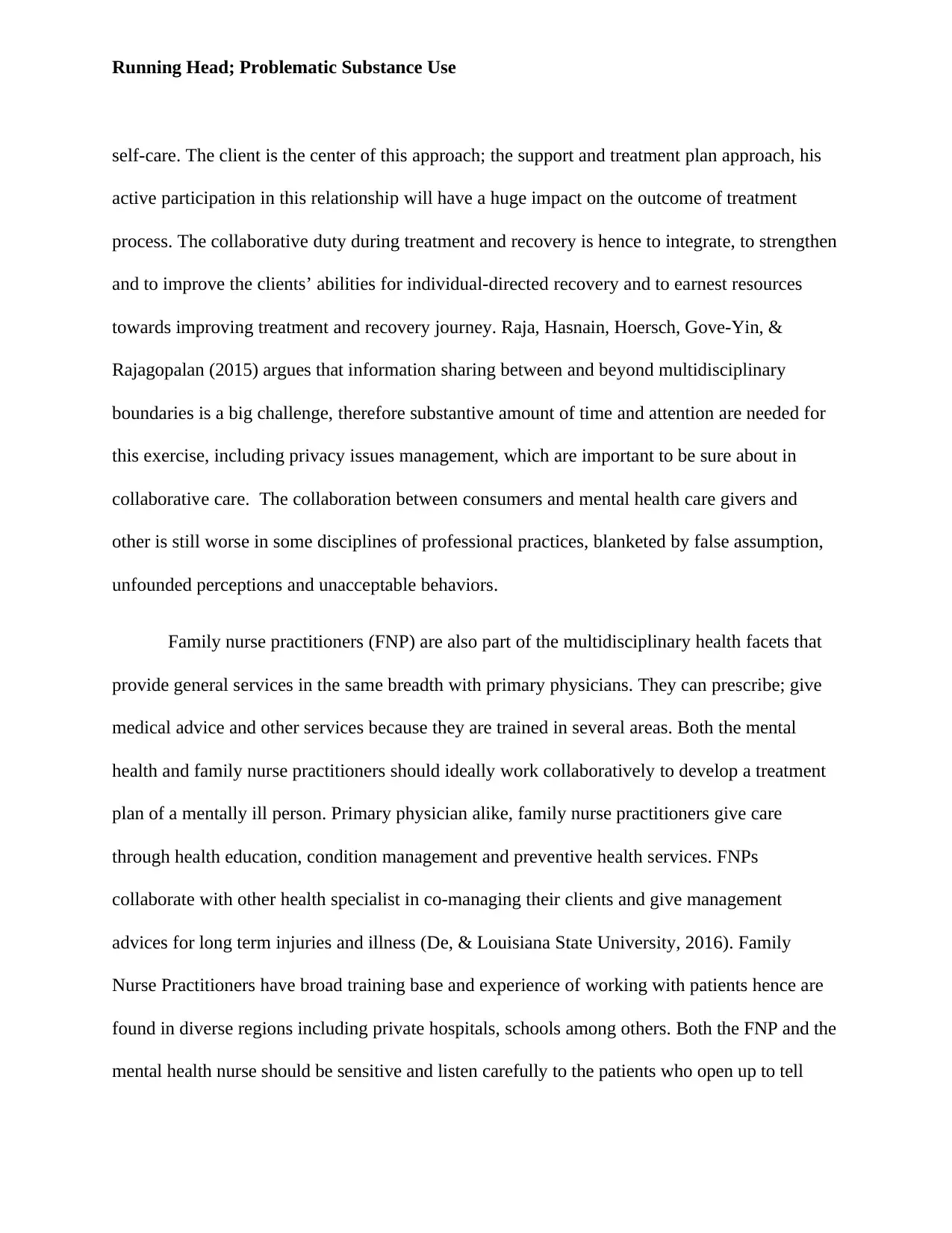
Running Head; Problematic Substance Use
self-care. The client is the center of this approach; the support and treatment plan approach, his
active participation in this relationship will have a huge impact on the outcome of treatment
process. The collaborative duty during treatment and recovery is hence to integrate, to strengthen
and to improve the clients’ abilities for individual-directed recovery and to earnest resources
towards improving treatment and recovery journey. Raja, Hasnain, Hoersch, Gove-Yin, &
Rajagopalan (2015) argues that information sharing between and beyond multidisciplinary
boundaries is a big challenge, therefore substantive amount of time and attention are needed for
this exercise, including privacy issues management, which are important to be sure about in
collaborative care. The collaboration between consumers and mental health care givers and
other is still worse in some disciplines of professional practices, blanketed by false assumption,
unfounded perceptions and unacceptable behaviors.
Family nurse practitioners (FNP) are also part of the multidisciplinary health facets that
provide general services in the same breadth with primary physicians. They can prescribe; give
medical advice and other services because they are trained in several areas. Both the mental
health and family nurse practitioners should ideally work collaboratively to develop a treatment
plan of a mentally ill person. Primary physician alike, family nurse practitioners give care
through health education, condition management and preventive health services. FNPs
collaborate with other health specialist in co-managing their clients and give management
advices for long term injuries and illness (De, & Louisiana State University, 2016). Family
Nurse Practitioners have broad training base and experience of working with patients hence are
found in diverse regions including private hospitals, schools among others. Both the FNP and the
mental health nurse should be sensitive and listen carefully to the patients who open up to tell
self-care. The client is the center of this approach; the support and treatment plan approach, his
active participation in this relationship will have a huge impact on the outcome of treatment
process. The collaborative duty during treatment and recovery is hence to integrate, to strengthen
and to improve the clients’ abilities for individual-directed recovery and to earnest resources
towards improving treatment and recovery journey. Raja, Hasnain, Hoersch, Gove-Yin, &
Rajagopalan (2015) argues that information sharing between and beyond multidisciplinary
boundaries is a big challenge, therefore substantive amount of time and attention are needed for
this exercise, including privacy issues management, which are important to be sure about in
collaborative care. The collaboration between consumers and mental health care givers and
other is still worse in some disciplines of professional practices, blanketed by false assumption,
unfounded perceptions and unacceptable behaviors.
Family nurse practitioners (FNP) are also part of the multidisciplinary health facets that
provide general services in the same breadth with primary physicians. They can prescribe; give
medical advice and other services because they are trained in several areas. Both the mental
health and family nurse practitioners should ideally work collaboratively to develop a treatment
plan of a mentally ill person. Primary physician alike, family nurse practitioners give care
through health education, condition management and preventive health services. FNPs
collaborate with other health specialist in co-managing their clients and give management
advices for long term injuries and illness (De, & Louisiana State University, 2016). Family
Nurse Practitioners have broad training base and experience of working with patients hence are
found in diverse regions including private hospitals, schools among others. Both the FNP and the
mental health nurse should be sensitive and listen carefully to the patients who open up to tell
⊘ This is a preview!⊘
Do you want full access?
Subscribe today to unlock all pages.

Trusted by 1+ million students worldwide
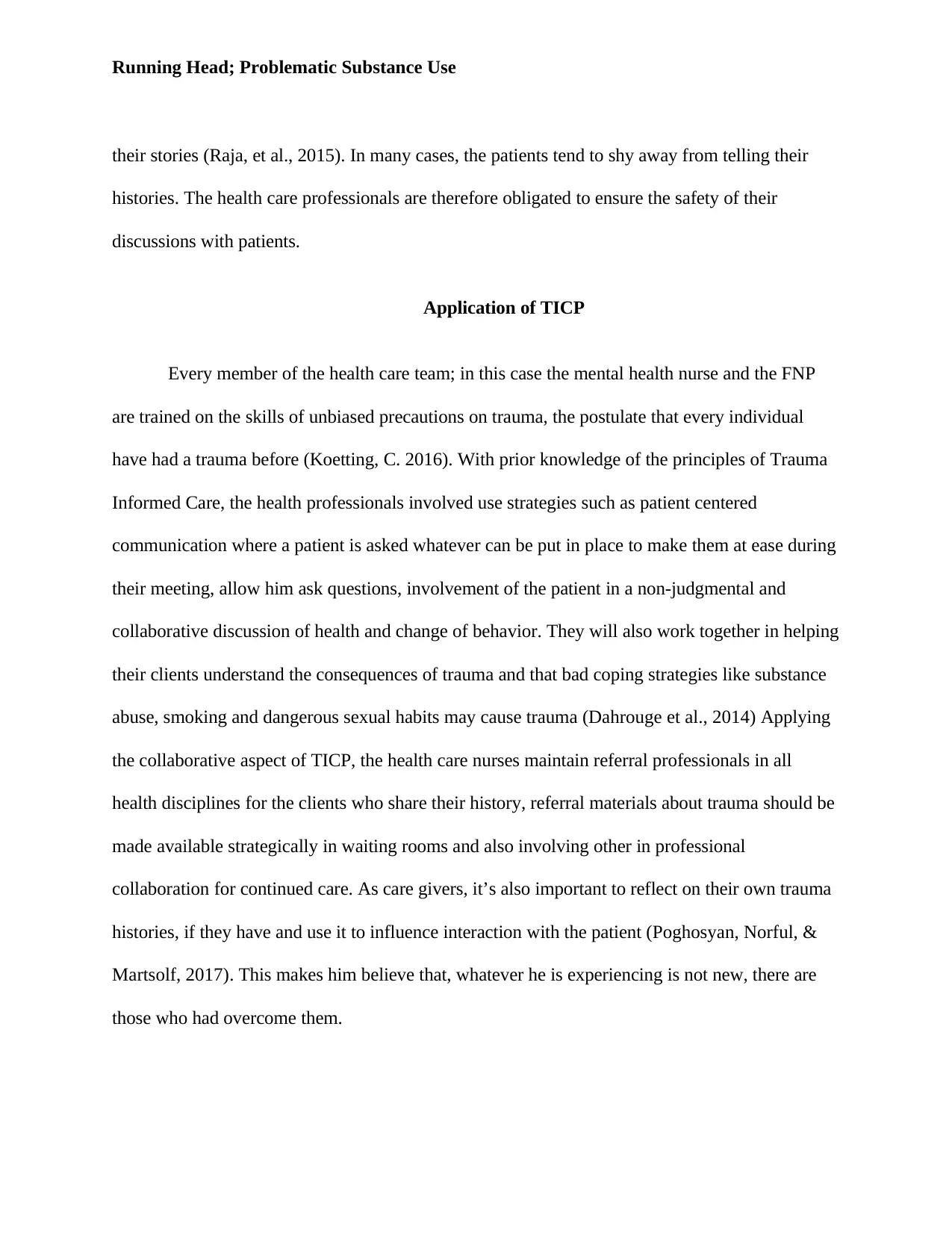
Running Head; Problematic Substance Use
their stories (Raja, et al., 2015). In many cases, the patients tend to shy away from telling their
histories. The health care professionals are therefore obligated to ensure the safety of their
discussions with patients.
Application of TICP
Every member of the health care team; in this case the mental health nurse and the FNP
are trained on the skills of unbiased precautions on trauma, the postulate that every individual
have had a trauma before (Koetting, C. 2016). With prior knowledge of the principles of Trauma
Informed Care, the health professionals involved use strategies such as patient centered
communication where a patient is asked whatever can be put in place to make them at ease during
their meeting, allow him ask questions, involvement of the patient in a non-judgmental and
collaborative discussion of health and change of behavior. They will also work together in helping
their clients understand the consequences of trauma and that bad coping strategies like substance
abuse, smoking and dangerous sexual habits may cause trauma (Dahrouge et al., 2014) Applying
the collaborative aspect of TICP, the health care nurses maintain referral professionals in all
health disciplines for the clients who share their history, referral materials about trauma should be
made available strategically in waiting rooms and also involving other in professional
collaboration for continued care. As care givers, it’s also important to reflect on their own trauma
histories, if they have and use it to influence interaction with the patient (Poghosyan, Norful, &
Martsolf, 2017). This makes him believe that, whatever he is experiencing is not new, there are
those who had overcome them.
their stories (Raja, et al., 2015). In many cases, the patients tend to shy away from telling their
histories. The health care professionals are therefore obligated to ensure the safety of their
discussions with patients.
Application of TICP
Every member of the health care team; in this case the mental health nurse and the FNP
are trained on the skills of unbiased precautions on trauma, the postulate that every individual
have had a trauma before (Koetting, C. 2016). With prior knowledge of the principles of Trauma
Informed Care, the health professionals involved use strategies such as patient centered
communication where a patient is asked whatever can be put in place to make them at ease during
their meeting, allow him ask questions, involvement of the patient in a non-judgmental and
collaborative discussion of health and change of behavior. They will also work together in helping
their clients understand the consequences of trauma and that bad coping strategies like substance
abuse, smoking and dangerous sexual habits may cause trauma (Dahrouge et al., 2014) Applying
the collaborative aspect of TICP, the health care nurses maintain referral professionals in all
health disciplines for the clients who share their history, referral materials about trauma should be
made available strategically in waiting rooms and also involving other in professional
collaboration for continued care. As care givers, it’s also important to reflect on their own trauma
histories, if they have and use it to influence interaction with the patient (Poghosyan, Norful, &
Martsolf, 2017). This makes him believe that, whatever he is experiencing is not new, there are
those who had overcome them.
Paraphrase This Document
Need a fresh take? Get an instant paraphrase of this document with our AI Paraphraser
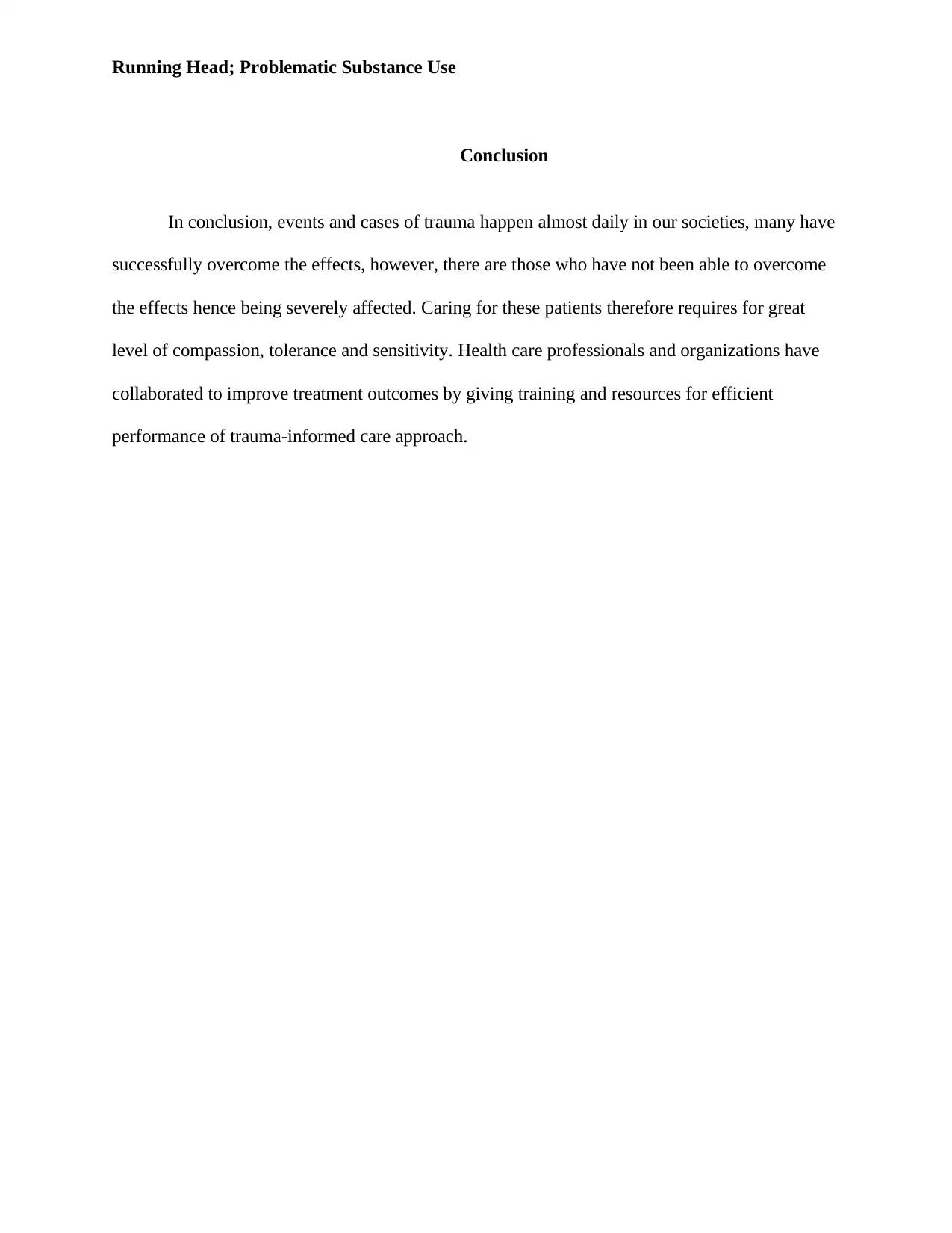
Running Head; Problematic Substance Use
Conclusion
In conclusion, events and cases of trauma happen almost daily in our societies, many have
successfully overcome the effects, however, there are those who have not been able to overcome
the effects hence being severely affected. Caring for these patients therefore requires for great
level of compassion, tolerance and sensitivity. Health care professionals and organizations have
collaborated to improve treatment outcomes by giving training and resources for efficient
performance of trauma-informed care approach.
Conclusion
In conclusion, events and cases of trauma happen almost daily in our societies, many have
successfully overcome the effects, however, there are those who have not been able to overcome
the effects hence being severely affected. Caring for these patients therefore requires for great
level of compassion, tolerance and sensitivity. Health care professionals and organizations have
collaborated to improve treatment outcomes by giving training and resources for efficient
performance of trauma-informed care approach.
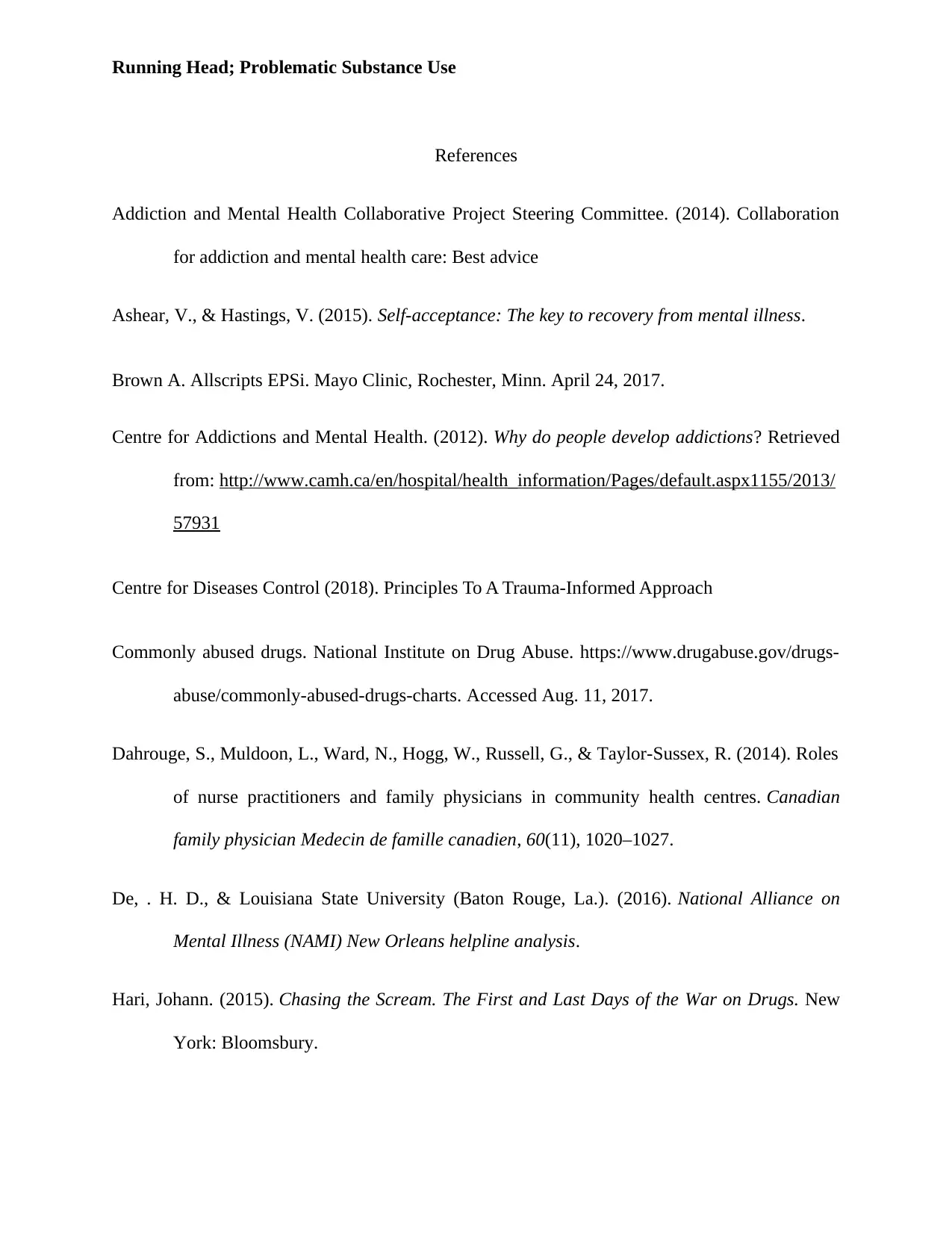
Running Head; Problematic Substance Use
References
Addiction and Mental Health Collaborative Project Steering Committee. (2014). Collaboration
for addiction and mental health care: Best advice
Ashear, V., & Hastings, V. (2015). Self-acceptance: The key to recovery from mental illness.
Brown A. Allscripts EPSi. Mayo Clinic, Rochester, Minn. April 24, 2017.
Centre for Addictions and Mental Health. (2012). Why do people develop addictions? Retrieved
from: http://www.camh.ca/en/hospital/health_information/Pages/default.aspx1155/2013/
57931
Centre for Diseases Control (2018). Principles To A Trauma-Informed Approach
Commonly abused drugs. National Institute on Drug Abuse. https://www.drugabuse.gov/drugs-
abuse/commonly-abused-drugs-charts. Accessed Aug. 11, 2017.
Dahrouge, S., Muldoon, L., Ward, N., Hogg, W., Russell, G., & Taylor-Sussex, R. (2014). Roles
of nurse practitioners and family physicians in community health centres. Canadian
family physician Medecin de famille canadien, 60(11), 1020–1027.
De, . H. D., & Louisiana State University (Baton Rouge, La.). (2016). National Alliance on
Mental Illness (NAMI) New Orleans helpline analysis.
Hari, Johann. (2015). Chasing the Scream. The First and Last Days of the War on Drugs. New
York: Bloomsbury.
References
Addiction and Mental Health Collaborative Project Steering Committee. (2014). Collaboration
for addiction and mental health care: Best advice
Ashear, V., & Hastings, V. (2015). Self-acceptance: The key to recovery from mental illness.
Brown A. Allscripts EPSi. Mayo Clinic, Rochester, Minn. April 24, 2017.
Centre for Addictions and Mental Health. (2012). Why do people develop addictions? Retrieved
from: http://www.camh.ca/en/hospital/health_information/Pages/default.aspx1155/2013/
57931
Centre for Diseases Control (2018). Principles To A Trauma-Informed Approach
Commonly abused drugs. National Institute on Drug Abuse. https://www.drugabuse.gov/drugs-
abuse/commonly-abused-drugs-charts. Accessed Aug. 11, 2017.
Dahrouge, S., Muldoon, L., Ward, N., Hogg, W., Russell, G., & Taylor-Sussex, R. (2014). Roles
of nurse practitioners and family physicians in community health centres. Canadian
family physician Medecin de famille canadien, 60(11), 1020–1027.
De, . H. D., & Louisiana State University (Baton Rouge, La.). (2016). National Alliance on
Mental Illness (NAMI) New Orleans helpline analysis.
Hari, Johann. (2015). Chasing the Scream. The First and Last Days of the War on Drugs. New
York: Bloomsbury.
⊘ This is a preview!⊘
Do you want full access?
Subscribe today to unlock all pages.

Trusted by 1+ million students worldwide
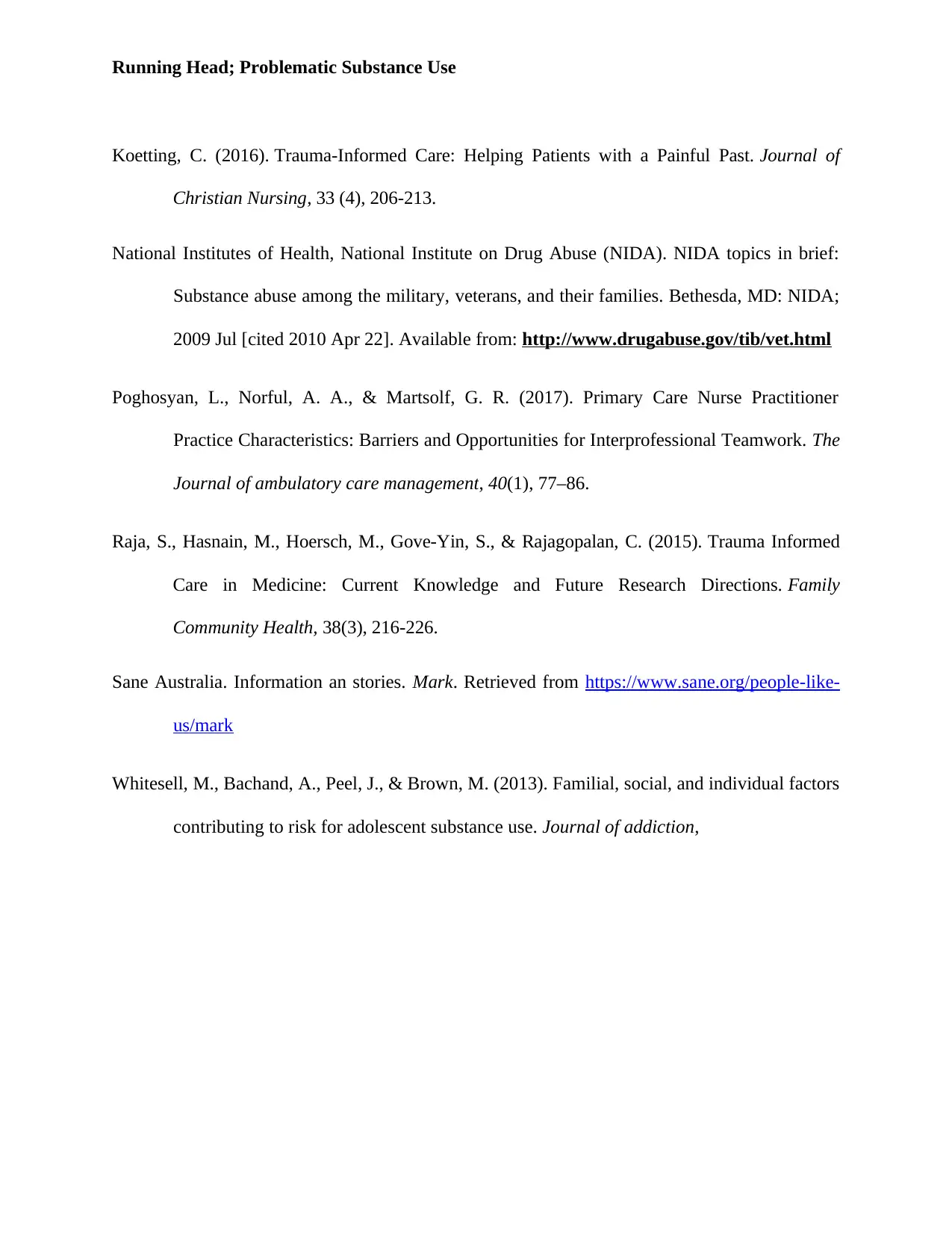
Running Head; Problematic Substance Use
Koetting, C. (2016). Trauma-Informed Care: Helping Patients with a Painful Past. Journal of
Christian Nursing, 33 (4), 206-213.
National Institutes of Health, National Institute on Drug Abuse (NIDA). NIDA topics in brief:
Substance abuse among the military, veterans, and their families. Bethesda, MD: NIDA;
2009 Jul [cited 2010 Apr 22]. Available from: http://www.drugabuse.gov/tib/vet.html
Poghosyan, L., Norful, A. A., & Martsolf, G. R. (2017). Primary Care Nurse Practitioner
Practice Characteristics: Barriers and Opportunities for Interprofessional Teamwork. The
Journal of ambulatory care management, 40(1), 77–86.
Raja, S., Hasnain, M., Hoersch, M., Gove-Yin, S., & Rajagopalan, C. (2015). Trauma Informed
Care in Medicine: Current Knowledge and Future Research Directions. Family
Community Health, 38(3), 216-226.
Sane Australia. Information an stories. Mark. Retrieved from https://www.sane.org/people-like-
us/mark
Whitesell, M., Bachand, A., Peel, J., & Brown, M. (2013). Familial, social, and individual factors
contributing to risk for adolescent substance use. Journal of addiction,
Koetting, C. (2016). Trauma-Informed Care: Helping Patients with a Painful Past. Journal of
Christian Nursing, 33 (4), 206-213.
National Institutes of Health, National Institute on Drug Abuse (NIDA). NIDA topics in brief:
Substance abuse among the military, veterans, and their families. Bethesda, MD: NIDA;
2009 Jul [cited 2010 Apr 22]. Available from: http://www.drugabuse.gov/tib/vet.html
Poghosyan, L., Norful, A. A., & Martsolf, G. R. (2017). Primary Care Nurse Practitioner
Practice Characteristics: Barriers and Opportunities for Interprofessional Teamwork. The
Journal of ambulatory care management, 40(1), 77–86.
Raja, S., Hasnain, M., Hoersch, M., Gove-Yin, S., & Rajagopalan, C. (2015). Trauma Informed
Care in Medicine: Current Knowledge and Future Research Directions. Family
Community Health, 38(3), 216-226.
Sane Australia. Information an stories. Mark. Retrieved from https://www.sane.org/people-like-
us/mark
Whitesell, M., Bachand, A., Peel, J., & Brown, M. (2013). Familial, social, and individual factors
contributing to risk for adolescent substance use. Journal of addiction,
1 out of 10
Related Documents
Your All-in-One AI-Powered Toolkit for Academic Success.
+13062052269
info@desklib.com
Available 24*7 on WhatsApp / Email
![[object Object]](/_next/static/media/star-bottom.7253800d.svg)
Unlock your academic potential
Copyright © 2020–2025 A2Z Services. All Rights Reserved. Developed and managed by ZUCOL.





